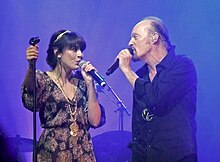Celtic music
The term Celtic music describes different musical genres of the folk music traditions of modern Celts . A distinction is made between different styles, ranging from traditional "Tradmusic" to the modern style of "Celtic fusion", a combination of different modern styles of music with "Celtic" music.
Stylistic delimitation
On the one hand, this music refers to the entire musical repertoire of musicians who see themselves as descendants of the earlier Celts . On the other hand, it refers to typical characteristics of the musical culture of the Celtic nations. Influential musicians on the scene, such as the Breton Alan Stivell or the Irishman Paddy Moloney , see not only differences in so-called celtic music , but also similarities. Some connecting melodic elements are relatively widespread in Celtic musical culture. Similarities can be found, for example, in a linear melody that is present in many “Celtic” songs , an up-and-down movement with mostly three basic chords . The suitable melody instruments are the bagpipe and harp . "Celtic" melodies are usually simply designed and allow extensive improvisation . The simple harmony allows for typical repeated cadences that structure these improvisations. The melody through its vast musical intervals voices the opportunity to linguistic accents come clear advantage. Often the term "Celtic music" is also used to describe the music of Ireland and Scotland , although both cultures have developed their own musical styles, but also have many similarities and mutual influences. A comprehensive definition is made difficult by the fact that Irish music is often marketed as "Celtic" music and does not do justice to this term.
With the influence of Irish and Scottish-born artists in the English-speaking world, particularly in the United States, the "Celtic" musical styles have influenced North American music, particularly bluegrass and country music .
The traditional musical styles of the regions of Wales , Cornwall , the Isle of Man , Brittany ( France ), Galicia , Cantabria and Asturias ( Spain ) and Portugal are also considered "Celtic music". This music is particularly cultivated in Brittany. Several “Celtic” festivals take place there every year. The Eisteddfod artists' festival, revived in the 18th century, takes place in Wales .
literature
- Bernhard Maier: The Celts. Your history from the beginnings to the present (= Beck's historical library. Series early peoples. ) CH Beck, Munich 2000, ISBN 3-406-46094-1 .
- June Skinner Sawyers: Celtic music: a complete guide. Da Capo Press, New York 2001, ISBN 0-306-81007-7 .
- Martin Stokes, Philip V. Bohlman (Eds.): Celtic modern: music at the global fringe. Scarecrow Press, Lanham, Md., 2003, ISBN 0-8108-4780-9 .
- Chris McDonald: Towards a Musicology of the Celtic Sound. Canadian Society for Traditional Music 2008.
- John T. Koch, Antone Minard: The Celts: History, Life, and Culture. 2 volumes. ABC-CLIO, Santa Barbara 2012.
- Volume 1: A-H. ISBN 978-1-59884-965-3 .
- Volume 2: I-Y. ISBN 978-1-59884-964-6 .
Web links
- What is Celtic music? standingstones.com (English)
- Irish music magazine (English)
- Breton music in Germany
- Festival Interceltique Lorient (Brittany) (English)
Individual evidence
- ^ Martin Melhuish: Celtic Tides: Traditional Music in a New Age. Ontario, Canada, 1998, pp. 8, 28.
- ↑ Alan Stivell's biography. ( Memento from July 31, 2014 in the Internet Archive )
- ^ Martin Melhuish: Celtic Tides: Traditional Music in a New Age. Ontario, Canada, 1998, pp. 77 and 79.

